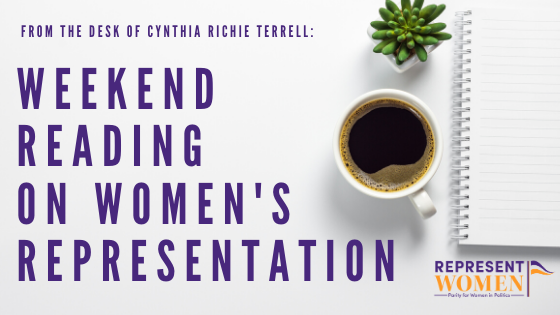
Weekend Reading on Women’s Representation is a compilation of stories about women’s representation in politics, on boards, in sports and entertainment, in judicial offices and in the private sector in the U.S. and around the world—with a little gardening and goodwill mixed in for refreshment!
This week there has been a whirlwind of news relating to the spread of the coronavirus and the new realities we are all facing. For some without adequate healthcare or underlying medical conditions the threat to life is grave while for others the challenges of working remotely and ‘social distancing’ are very real. My youngest daughter is a college senior and so is bracing for an anti-climatic end to her collegiate career.
I thought this photo article in The New York Times by Anemona Hartocolis and Kayana Szymczak is a beautiful tribute to the many students who organized their own graduation ceremonies before they left campus:
The notice came out of the blue: Like so many other colleges across the country, Wellesley would be closing campus because of the coronavirus, moving to remote learning. Students would leave for spring break and not some back. For many seniors, there was one loss that hurt above all: graduation, and the traditions that some with it. So they decided to make their own. Some referred to it as “fake graduation” or “fauxmencement.” There were no deans. Students called their own names.
There was a powerful article on the impact of the coronavirus on women by Helen Lewis in The Atlantic entitled “The Coronavirus Is a Disaster for Feminism“:
Enough already. When people try to be cheerful about social distancing and working from home, noting that William Shakespeare and Isaac Newton did some of their best work while England was ravaged by the plague, there is an obvious response: Neither of them had child-care responsibilities.
Shakespeare spent most of his career in London, where the theaters were, while his family lived in Stratford-upon-Avon. During the plague of 1606, the playwright was lucky to be spared from the epidemic—his landlady died at the height of the outbreak—and his wife and two adult daughters stayed safely in the Warwickshire countryside. Newton, meanwhile, never married or had children. He saw out the Great Plague of 1665–6 on his family’s estate in the east of England, and spent most of his adult life as a fellow at Cambridge University, where his meals and housekeeping were provided by the college.
For those with caring responsibilities, an infectious-disease outbreak is unlikely to give them time to write King Lear or develop a theory of optics. A pandemic magnifies all existing inequalities (even as politicians insist this is not the time to talk about anything other than the immediate crisis). Working from home in a white-collar job is easier; employees with salaries and benefits will be better protected; self-isolation is less taxing in a spacious house than a cramped apartment. But one of the most striking effects of the coronavirus will be to send many couples back to the 1950s. Across the world, women’s independence will be a silent victim of the pandemic.
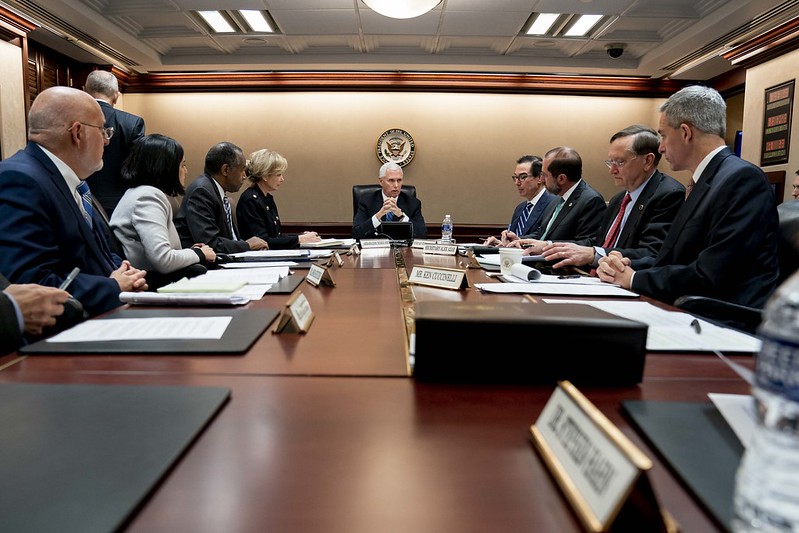
Erin Loos Cutraro, founder and CEO of She Should Run, had a piece on Thrive Global about the impact of the virus on women that is also an important read:
It’s a challenge to not be inundated by the force of the global panic we’re facing around the COVID-19 outbreak, which is now officially recognized as a pandemic. Like many, my new reality includes working from home with young kids no longer in school, financial uncertainty and real fears about the health of my family and friends.
The fallout of the virus on our society is apparent in very real ways, and not just by the people who’ve been exposed to it. Markets are volatile. Elections are in question. Schools and offices are closing, leaving students and employees to learn or work remotely. Conferences are going online, festivals getting nixed. Sports leagues are suspending their entire season, and weddings and birthday parties are getting postponed or canceled entirely.
All these events will have a long-lasting impact and deserve the attention they’ve been getting. But there’s something important about the coronavirus that few people are talking about: Women are set to be disproportionately affected by the pandemic.
Women already do 2.6 times the unpaid care for families and work around the house that men do. Given many are already handling the bulk of planning and caretaking in families, the new pressures brought on by kids at home and reduced wages is creating scenarios previously unimaginable for many.
Also, let’s consider the wage gap. Our lowest-wage workers are Latina women, who are paid 47 percent less than men on average.These lower-wage workers very often have jobs that focus on face-to-face contact, so as we enact “social distancing” policies, they are likely to be among the hardest hit by the virtual shut-down of our society as usual.
Paid leave is another serious concern as many businesses reduce hours or close their doors altogether to help prevent the spread of the virus. Take for instance black mothers. More than 80 percent of black mothers are their family’s breadwinner, yet 70 percent don’t have access to any type of paid leave. With women overall making up over 40% of the gig economy, access to healthcare and leave continues to be a growing issue. Even more, there’s a budding childcare crisis as schools begin to close and women have to choose between their paycheck and staying home with their young ones.

The She Should Run team also shared two great timely resources as we all adjust to a new reality:
- Tips from the Team: How to Work Remotely
- 3 Considerations: How We Operate Effectively as a Virtual Organization by Christina Jackson Scott, She Should Run Chief of Staff
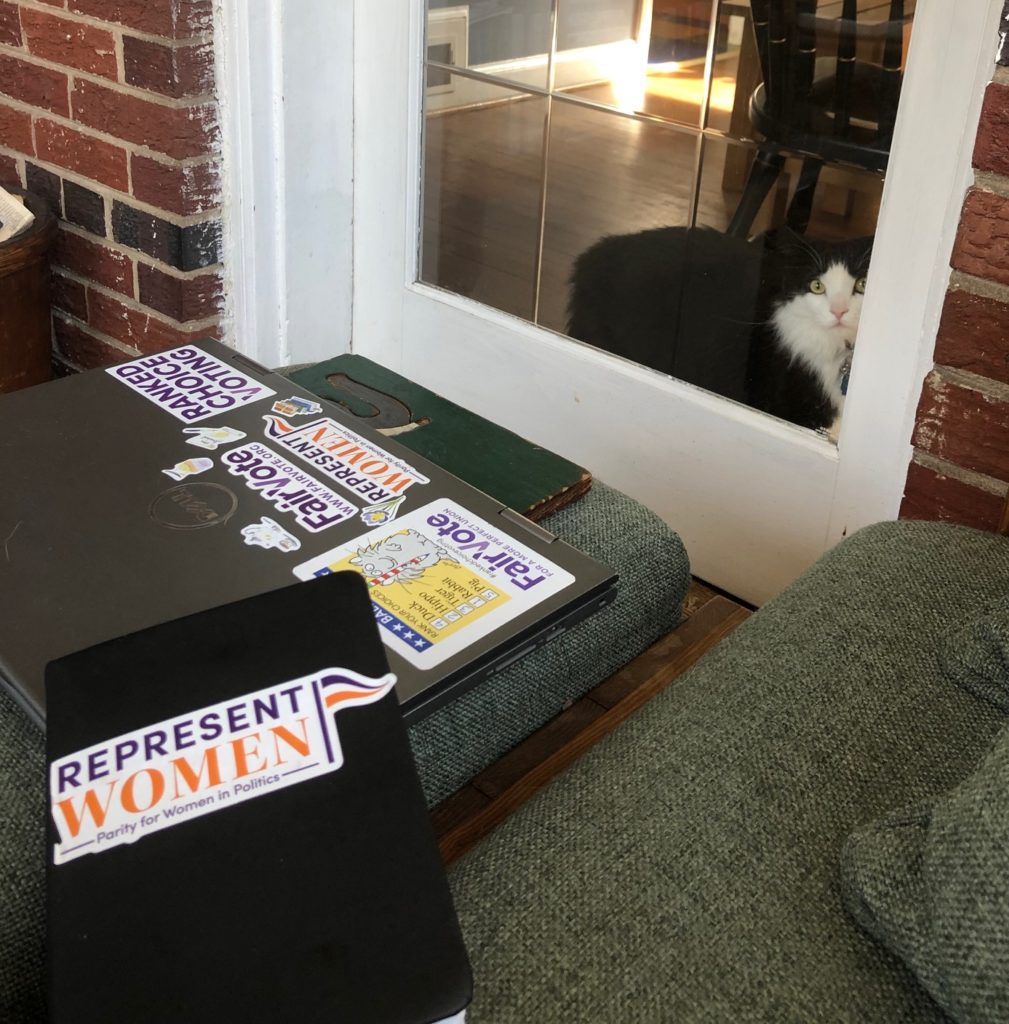
Working from home means new distractions for all of us—my cat was very interested in the webinar on data visualization that I attended this week. Good luck staying focused!
While the coronovirus has disrupted the electoral process in a number of states the debates and the nomination contests continue. During the debate between the two leading democratic candidates on Sunday night, former Vice President Joe Biden pledged to name a woman as his running mate.
Jay Newton-Small wrote about this announcement, and the pushback, in this good read in The Washington Post:
Former vice president Joe Biden’s mid-debate promise to pick a female running mate, should he win the Democratic presidential nomination, was scorned by some conservative women:
“Biden has done a disservice to his future running mate by emphasizing her gender rather than her accomplishments,” wrote Washington Examiner columnist Kaylee McGhee. “Now, whomever he chooses, whether it’s Amy Klobuchar, Stacey Abrams, or Sally Yates, will be seen as the most inclusive option, rather than the most accomplished.”
White House adviser Kellyanne Conway, Donald Trump’s 2016 women’s vote whisperer, took a more nuanced view when I emailed her:
“It is unwise for Biden to have set such an intractable marker,” she wrote. “It feels part contrived, part consolation prize given the high number of women who actually ran against him for President in the primaries.”
But to some degree, her point undermines the conservative trope that the most qualified person, versus the most qualified woman, should be on the ticket. There’s simply no doubt that there are plenty of women qualified to be vice president. This year, six of them ran for the top job, a historic field, including five sitting members of Congress. “The idea that picking the best qualified person is at odds with picking a woman, if ever true, is not in 2020,” says Martha Coakley, former Massachusetts attorney general. “Women have the experience, savvy and smarts to be a great VP and by extension, the President. Witness the Democratic Primary.”
… The principle of reflecting a diverse electorate has held true for American administrations, Republican or Democratic, for decades, according to Karen Beckwith, chair of Case Western Reserve University’s political science department and a co-author of “Cabinets, Ministers, & Gender.” “Since 1985, every initial U.S. cabinet has included at least one woman, and there has not been an all-white cabinet since 1975,” she says. For a position like vice president, choosing a diverse candidate is especially important as “there are no agreed, specific criteria that ‘qualify’ a vice presidential candidate on the basis of ‘merit.’”
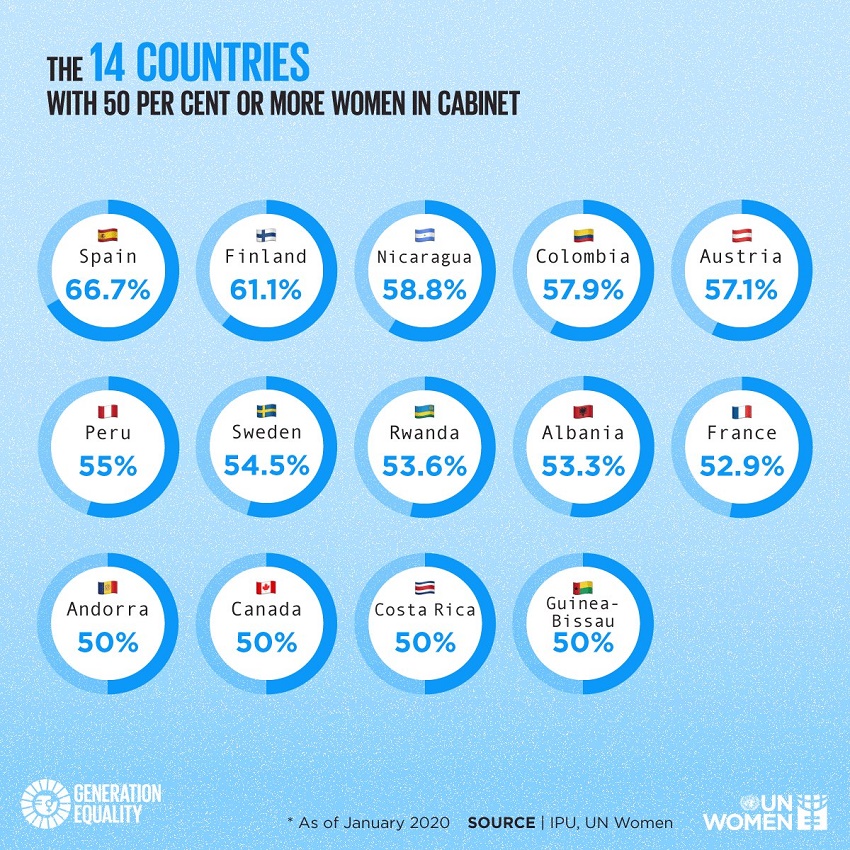
UN Women posted this terrific infographic reporting on the 14 countries with 50 percent or more women appointed to cabinets at the national level—find out more about their excellent work here:
Overall, the proportion of women ministers is at an all-time high at 21.3 per cent (851 out of 4003), which is 7.1 percentage points higher than in 2005 when only 14.2 per cent of ministers were women.
In the 190 countries for which data is available, men continue to dominate certain ministerial portfolios. For example, there are only 25 finance / budget portfolios and 22 defense portfolios led by women ministers.
Conversely, despite some shifts in recent years, women ministers are still most likely to oversee family and social affairs, followed closely by environment and energy portfolios.

Debbie Walsh and the top-notch team at the Center for American Women and Politics released this statement on the departure of Rep Tulsi Gabbard and the end of the presidential nomination process for women candidates:
The 2020 presidential campaign began with six women candidates running in the Democratic primary, a record level of participation, including four U.S. Senators, a four-term U.S. Representative, and a successful entrepreneur.
Now there are none.
From the beginning, the 2016 campaign loomed over 2020 and one question was repeated continuously throughout the primary: Can a woman win? It has become a self-fulfilling prophecy.
Women can win. Hillary Clinton showed this in 2016 when she won an overwhelming popular vote victory. Women at all levels, in all kinds of districts, showed this in 2018 when they set records for political representation in the Congress and around the country.
As we’ve discussed throughout this election cycle, women are forced to run dual campaigns: a traditional campaign to show that they are the best person for the job and an additional campaign appealing to political analysts, donors, and the media, as well as voters, to prove that they are “electable” at all.
Someday a woman will be President of the United States. But it won’t happen in an environment where women are hobbled by different, and greater, expectations than their male counterparts.
It’s time to change the way we talk about women candidates.
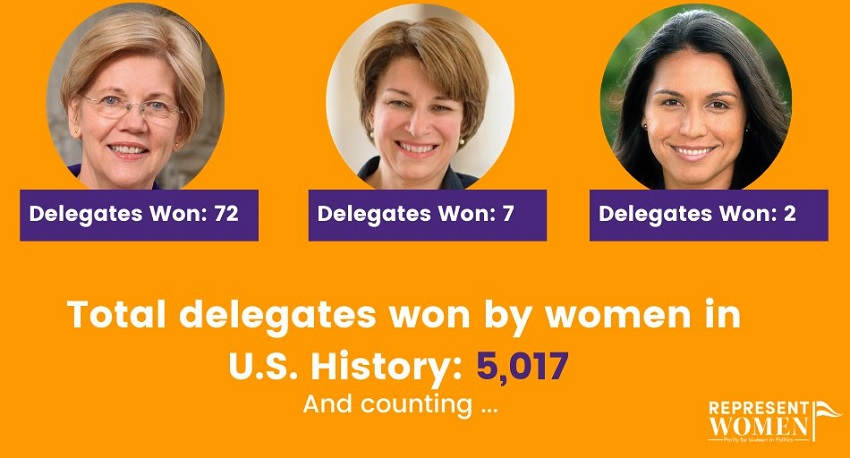
The RepresentWomen team has of course been tracking the women presidential candidates as well and posted this tally of the delegates won in 2020 and in the history of the United States.
For more details, read this excellent piece by Maura Reilly in Ms Magazine “5 Women, 56 Years, 4,936 Delegates: The History of Women Winning Primaries“:
Women began vying for the presidency before they even had the right to vote. In 1872, Victoria Woodhull became the first woman to run for President of the United States, nearly 50 years before it would be legal for her to vote. She ran as the nominee for the Equal Rights Party, despite being unable to vote and too young to hold the position, and she continued to be a staunch advocate for women’s suffrage after her loss.
Despite Woodhull’s early run, no woman candidate won a primary delegate for almost a century—when, in 1964, Margaret Chase Smith, a Republican Senator from Maine, entered the Republican Primary. Smith had a long career full of political firsts: she was the first woman to serve in both the U.S. House and Senate, spoke as a surrogate for incumbent President Dwight Eisenhower during the first televised presidential debate in 1956.
In January 1964, Smith officially announced her bid for the nomination at the Women’s National Press Club. When asked which Republican candidate she would support for the presidency, Smith responded: “I must answer that I’m a candidate for president and I’m not supporting anybody else.”
Smith competed in three states during the Republican primary: New Hampshire, Illinois and Oregon. She won a total of 27 delegatesand came in second in delegate count during the Republican National Convention—losing to the nominee Senator Barry Goldwater, who would go on to lose to President Lyndon B. Johnson in the general election.
“There is always a periphery story about a convention, and women are often in it,” the LA Times observed. “Wednesday one woman was no longer in the periphery. She stepped out of the context and into history. She was able to do what no other woman has since this country began—be formally nominated at the national convention of a major party for the office of President.”
Representative Shirley Chisholm, who became the first African-American woman elected to the U.S. House in 1968, launched her own campaign for the presidency in 1972. The “Unbought and Unbossed” candidate was barred from the primary debates and only included on the ballot in 12 states, but despite both the systemic barriers of race and gender and the roadblocks put up by the Democratic National Committee, Chisholm won 28 delegates across the 12 states and went on to earn 152 delegates at the Democratic Convention. Chisholm garnered extra delegates when Hubert H. Humphrey released his delegates before the first Convention ballot.
While hundreds-off from the needed delegates to clinch the nomination, Chisholm hoped for a brokered convention to use her 152 delegates to negotiate a Black running mate, a woman Cabinet Secretary and a Native American Secretary of the Interior. Unfortunately, Senator McGovern had 1,729 delegates and easily received the nomination without Chisholm’s delegates or requests.
It’s always great to see stories like this one in Teen Vogue this week entitled “Why Representation in Politics Actually Matters” by Sophie Vaughan:
Symbolic representation also provides the crucial ingredient of trust needed for the successful relationship between the governors and governed in any democratic society. In 2016, Piscopo and her research partners Amanda Clayton of Vanderbilt University and Diana O’Brien of Indiana University ran a series of survey experiments asking Americans to read fictitious articles about state legislative committees with varying levels of gender balance that were evaluating sexual harassment policies. The findings showed a resounding rejection of all-male panels that decided to decrease penalties for sexual harassers, with respondents saying they were less likely to agree with the outcome, more likely to believe the process was unfair and the decision should be overturned, and less trustful of the overall results. “When the folks in office are more diverse and gender-balanced we see people have more trust in government and participate in politics more. The paradox is all these stereotypes make it hard for women to get into office in the first place,” Piscopo told Teen Vogue.
Recent research from Wolbrecht and fellow Notre Dame University professor David Cambell also confirms the relationship between representation and trust in government, especially among girls. Based on a national sample of 997 American teenagers, ages 15–18, administered in the fall of 2016 before the election, and then again in 2017, Wolbrecht and Cambell found a drastic decline in how girls, especially those identifying as Democrats, viewed the state of American democracy. In 2016, 37% of Democratic girls thought politics helped meet their needs. A year later that belief had dropped by 20 percentage points.
But when these same teens were interviewed again in 2018, Democratic girls’ trust in democracy rebounded back to 30%, a result Wolbrecht and Campbell credit to the historic number of women who ran in the 2018 midterm elections. Increased faith in politics was especially pronounced among Democratic girls who lived in places where one or more women ran for the U.S. House, Senate, or governor. On the other hand, the trust remained stagnant in areas where there were no women candidates.
This “role model effect” is important not only for trust in government, but also for another critical element of democracy: civic engagement. As Wolbrecht and Cambell write, young women tend to become more politically engaged when they see women engaging in visible, viable campaigns, a finding bolstered by research from Tiffany Barnes, an associate professor of political science at the University of Kentucky. Using data from 20 countries in sub-Saharan Africa, Barnes discovered a direct relationship between women’s representation and political engagement. “Having more women in office, and in visible political positions, is associated with more women engaging in activities like protest or talking about politics, and contacting a representative more frequently,” Barnes told Teen Vogue.
On a substantive policy level, the evidence shows women’s legislative effectiveness is greater than men’s. And although the backgrounds of women are far from monolithic, women overall bring different, valuable perspectives to the currently male-dominated process, Dittmar said. “We value the experience of someone who has had military experience or lived abroad, so, why wouldn’t we value the distinct experience women have in society?”

Finally, there was a story in the New Indian Express about the long road to gender equality in Pakistan, by Karamatullah K Ghori:
The International Women’s Day, March 8, was celebrated by activists and advocates of women’s gender parity with men in Pakistan with their own special panache. To their misogynistic critics and male chauvinists, this was more spin than panache.Women’s rights activists had, weeks in advance, given this year’s Women’s Day their own epithet. They called it Aurat (Woman) March. Which was okay to all and sundry. But what became the bone of contention between advocates of women’s rights demanding equality with men and their detractors was the slogan coined to drive home the message: Mera jism, meri marzi (My body, my will).
Vocal critics of the slogan—of whom there’s nary a dearth in Pakistan’s tradition-bound and stridently patriarchal social milieu—took exception to the thrust of the slogan. To them, it was, first and foremost, a Western import and, secondly, obscene and un-Islamic.
To the extent of the Women’s March slogan being a Western import, the critique had a ring of authenticity. It was a rehash of the pro-choice advocates’ battle cry in the US where it’s still at the epicentre of their long confrontation with conservatives and ultra-rightists, to whom women’s demand for their right to abortion is anathema. Why should women’s rights standard-bearers make a provocative Western slogan—which has remained controversial even there—their shibboleth in a conservative and highly religious society like Pakistan, wonder even some of those sympathetic to the women’s cause.
To those opposed to women’s rights—the obscurantist religious brigade of bigoted mullahs and their purblind followers—it was like a red rag to an enraged bull. They pounced on it, decrying activist women as agents of anti-Islam and anti-Pakistan forces and calling upon the government to ban the March 8 ‘Aurat March’. Some zealots sued the Islamabad High Court to give an injunction against the march.
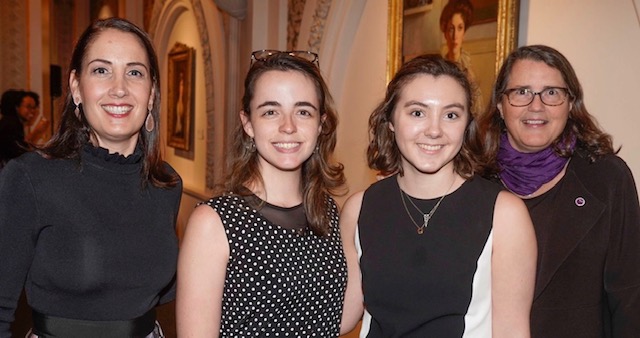
One more photo from a fun evening at Running Start’s Young Women to Watch Awards gala—which is always fun—but this year marks the last public event that I suspect many of us will attend for some months.





